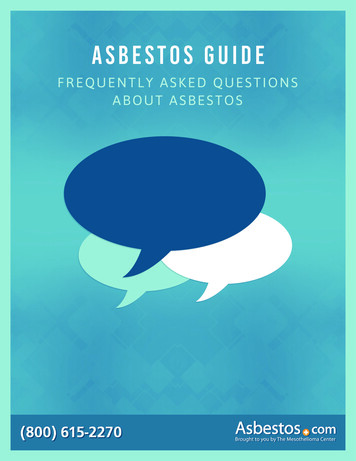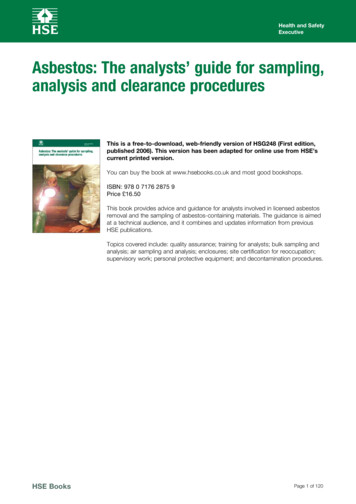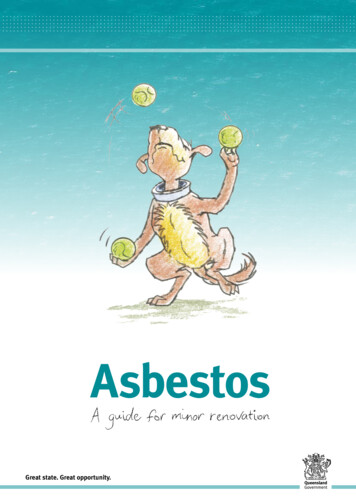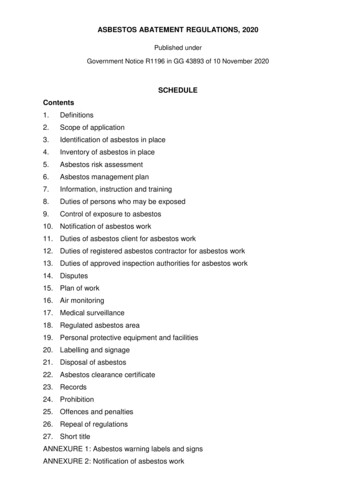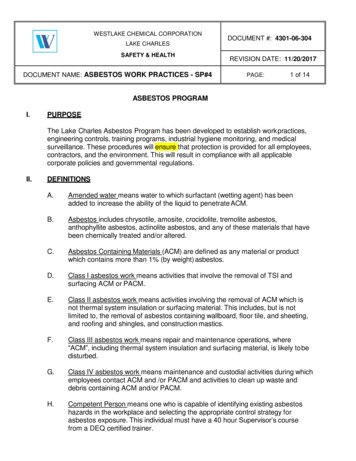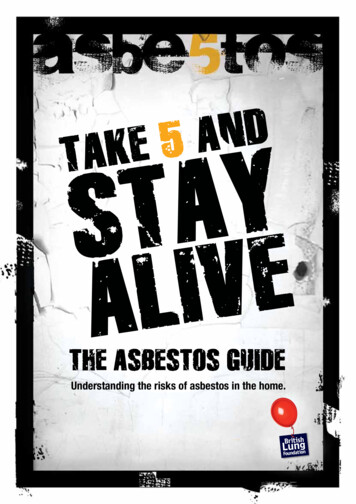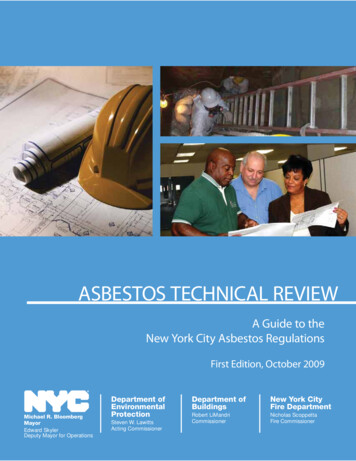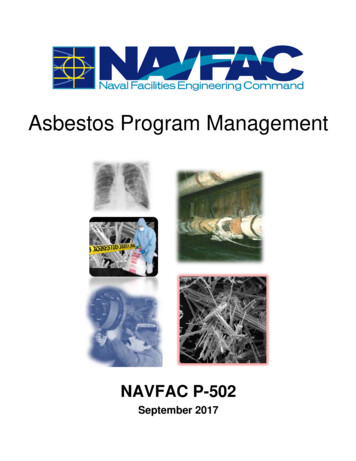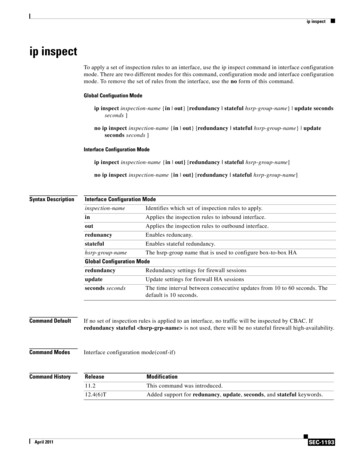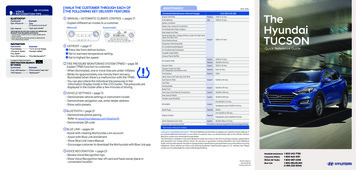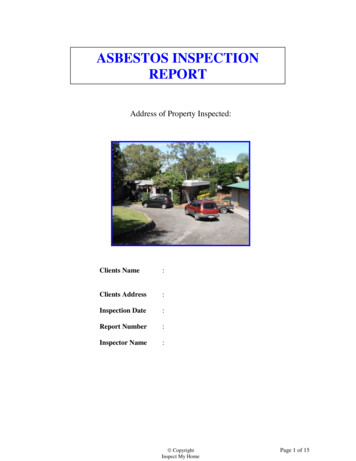
Transcription
ASBESTOS INSPECTIONREPORTAddress of Property Inspected:Clients Name:Clients Address:Inspection Date:Report Number:Inspector Name: CopyrightInspect My HomePage 1 of 15
CONTENTS1. Summary of Asbestos Containing Materials located, Asbestos Registry Audit Form & Photos.1.1Notes and Further Recommendations2. Conclusion.2.12.22.3Removal of asbestos.Policy development for asbestos products.Signage and labeling.3. Scope of the inspection.4. Methodology of the inspection.5.Limitations of the inspection.6. Legislative requirements.7. Terms used in Asbestos Registers8. Maintenance Work Flow-Chart.9. Health risks of Asbestos.10. Glossary of terms CopyrightInspect My HomePage 2 of 15
1.0SUMMARY OF ASBESTOS CONTAINING MATERIALS LOCATED.At the request of -------------, Inspect My Home carried out an asbestosmaterial inspection report of a building located at ------------------------------------------ on the -----------------------.Asbestos Containing Materials that were visually identified or found through sample analysis.ASBESTOS CONTAINING MATERIAL WAS IDENTIFIED IN THE: 1.1VENT PIPE.HOUSE EAVE SHEETING.HOUSE FASCIA SHEETING.INFILL PANELS AROUND WINDOWS.NOTES SAMPLES WERE TAKEN FROM THE ORIGINAL SECTION OF THE MAIN RESIDENCE. THE OWNER (DENISE) INFORMED ME THE GRANNY FLAT AND EXTENSION TO THEMAIN RESIDENCE WAS CARRIED OUT IN 1990 AND THE GAMES ROOM IS LESS THAN 10YEARS OLD. NO INSPECTION TO CONCEALED AREAS. NO INSPECTION TO ELECTRICAL SYSTEM – RECOMMEND SEEKING FURTHER ADVICEFROM A LICENCED AND PRACTICING ELECTRICIAN. ALL TENANTS SHOULD BE FURNISHED WITH A COPY OF THE ASBESTOS AUDIT REPORTAND HAVE THE REPORT READILY AVAILABLE FOR TRADESPOEPLE ENGAGED TOCARRY OUT REPAIRS / ALTERATIONS OF THE PROPERTY. ANY RENOVATIONS / ALTERATIONS INVOLVING THE PRODUCTS AND MATERIALSNOTED IN THIS REPORT REQUIRES PRECAUTION TO PROTECT WORKERS AND OR ASPECIALIST CONTRACTORS INVOLVEMENT. CopyrightInspect My HomePage 3 of 15
ASBESTOS REGISTRY AUDIT FORMSITE: -------------------------------- NAME: ES AND FORMS OF ASBESTOSPRODUCTS/MATERIAL100mm DIA PIPE.LOCATION/NOTESFLAT SHEET.LOCATION/NOTESFLAT SHEET.LOCATION/NOTESFLAT SHEET.LOCATION/NOTESFLAT SHEET.LOCATION/NOTESSAMPLE TAKENSAMPLE NO: SIMILARYES/NO.TONO--PHOTONO.1SUSPECTEDYESNO DATE: --/--/--ASBESTOSTYPECONDITIONPRIORITYAPPROX QUANTITYAREA/LENGTH Eg (Sq.M)-FAIRMEDIUM10.0 Sq.MVENT PIPES - NO SAMPLE TAKEN AS PIPE WILL CONTAIN ASBESTOS.YES1-2 CHFAIRMEDIUM60.0 Sq.M-13 CHFAIRMEDIUM40.0 Sq.M4 CHFAIRMEDIUM20.0 Sq.M5 CHGOODLOW2.0 Sq.MHOUSE - EAVE SHEETS.NOHOUSE – FASCIA SHEETING.YES2INFILL PANELS AROUND WINDOWS.NO-1ENTRY CEILING SHEET.LOCATION/NOTESPlease Note:Materials that have been deemed to be similar to any sample (which has been identified as containing asbestos) but has not beentested will be classified as undetermined. CopyrightInspect My Home
PHOTOSPHOTO 1PHOTO 2PHOTO 3PHOTO 4PHOTO 5 CopyrightInspect My HomePage 6 of 15
2.0CONCLUSIONThe inspection of the building and the subsequent sample analysis of materials suspected ofcontaining Asbestos identified the following types of Asbestos Containing Materials.THE ASBESTOS CONTAINING MATERIAL MARKED AS IS IN FAIR CONDITIONSHOULD BE STABILISED AND SCHEDULED FOR REMOVAL DURING MAINTENANCEAS THERE ARE SIGNS OF DETERIORATION.THE ASBESTOS CONTAINING MATERIAL MARKED AS IS IN GOOD CAN BE LEFTINSITU AND MONITORED REGULARLY FOR ANY DETERIORATION / DAMAGE.If removal, maintenance or repair tasks need to be carried out upon any of these items please referSection 8.6 “Maintenance Work Flow-Chart” - on how best to proceed. These products do not posea risk from exposure to airborne fibres so long as the materials are not disturbed or have workcarried out upon them. I.e. cut sanded, drilled etc. Attachment 8.6 contains a summary of healthrisks.2.1REMOVAL OF ASBESTOSAny samples identified during this inspection as priority immediate or high and/or havingdeteriorated to an unserviceable condition should be removed as soon as practical. Potential forexposure exists.2.2POLICY DEVELOPMENT FOR ASBESTOS CONTAINING MATERIALSWe recommend that specific policies on different aspects of asbestos management be developedand documented in Workplace Health & Safety Plans and Quality Systems. We would suggest thefollowing topics be covered, 2.3Asbestos product management: comprising care, maintenance, repairs & clean up ofdamaged areasResponsibilities of contractors and sub-contractors regarding asbestos on this siteSIGNAGE & LABELLINGIn accordance with the Workplace Health & Safety Regulations an asbestos materials registernotification sign shall be affixed to “an appropriate prominent place”. This applies only to thebuildings that contain “asbestos material”.The register must be on-site and is to be made available to: Workers and their representatives Any other employers within the premises Any person removing ACM Any person engaged to perform work that may disturb ACM Any other person who might be exposed CopyrightInspect My HomePage 7 of 15
3.0SCOPE OF THE INSPECTIONThe purpose of the inspection report was to determine the presence of any asbestos materials in thebuilding in accordance with Queensland’s Workplace Health & Safety.This report specifically refers to a visual inspection on areas of the building that were safelyaccessible at the time of the inspection to identify Asbestos Containing Materials which may be inthe building.Reference may be made to other Asbestos Containing Materials that are not thermal or acousticinsulation and as such are not covered by the legislation.Queensland’s Workplace Health & Safety Amendment Regulation (No.1) 2000, Section 69 refers to“asbestos materials” installed in the building, including in essential plant in or on the building. TheWorkplace Health and Safety Regulations – 1997 defines “asbestos materials” as “installed thermalor acoustic insulation materials comprising or containing asbestos”.Examples of installed thermal or acoustic insulation materials comprising or containing asbestoswould be: Asbestos lagging on steam/hot water pipes Asbestos material sprayed on steel beams Asbestos millboard installed in air-conditioning ductwork where heater banks arepresentThis type of material may be referred to as friable asbestos products, which means that it is looselybound and could quite easily liberate fibres to the air if disturbed.The more common use of asbestos in Queensland is in the form of gaskets, brake shoes, andbuilding products, e.g. fibro sheeting and pipe work and some vinyl floor tiles. The asbestos fibresin this type of material are bound into a matrix of cement, plastic or resin and as such are not likelyto be liberated into the air if disturbed. These materials may be referred to as bonded asbestosproducts.Bonded asbestos products are now covered by the new legislation.The contents of this report are not privileged and may be distributed to third parties including futureowners and occupiers of the relevant property. This concession is made on the proviso that thereport is only reproduced in full and that alterations are not made to the report without the expresspermission of INSPECT MY HOME.All Materials / Products located will be classified as suspected Asbestos Containing Materialsunless samples are taken and tested. CopyrightInspect My HomePage 8 of 15
4.0METHODOLOGY OF THE INSPECTIONThe inspection report survey involved visually inspecting each accessible area of the building forthe purpose of identifying Asbestos Containing Materials, as defined under the Workplace Healthand Safety.The process of identifying asbestos materials is as follows: Gathering information – age of building, type of building products used. Visual inspecting – gaining access to all areas available safely. Taking samples – samples are taken where possible of suspect materials and products, allsamples are sent and tested at a competent & accredited laboratory. The Asbestos Register will identify the samples taken and tested, it may also refer to othermaterials within the property which in the consultants opinion are similar, however whilethe materials may appear similar they may not be identical. Report and summary – the report outlines findings, health risks and if asbestos is present. The presence of asbestos or asbestos containing materials installed in a building or plant &equipment can only be confirmed visually and backed by sample analysis in a certifiedlaboratory. An appropriately qualified person will take samples of suspected materials andhave them analysed in a laboratory to confirm the presence of asbestos. Therefore limitingsamples taken will decrease the confidence in the Asbestos Audits findings and theAsbestos Materials Report generated from it. There is no device or instrument at the moment that can automatically detect asbestos.5.0LIMITATIONS OF THE INSPECTIONINSPECT MY HOME has made every effort to identify all Asbestos Containing Materialscontained within the building, together with basic items of plant and equipment but no warranty,expressed or implied, is made to the completeness of this inspection and report. During the courseof a visual non-destructive asbestos inspection it may not be possible to identify the presence of allasbestos materials. In many instances, asbestos materials may be present in areas that cannot beaccessed without implementing destructive sampling techniques. Such areas may include: wall cavities & internal pipe work penetrations in solid walls and concrete floor slabs integral parts of machinery, plant and pipe work fire dampers and reheat units within air conditioning ducts, and inaccessible service ducts / risers no air monitoring has been carried out during this inspection CopyrightInspect My HomePage 9 of 15
Samples were not taken of suspect materials that may have placed the inspector at risk of injury ordeath at the time of the inspection. High-risk asbestos situations that may be identified during aninspection may include internals of electrical switchboards and substations. Generally it isimpossible to locate all asbestos within a building in the course of an audit. This is due to factorssuch as, To avoid damage to the building-asbestos may be hidden behind walls or floors/floorcoverings or above fixed ceilingsPlant or equipment within the building which contains an asbestos component included bythe manufacturerNo plant or building plans available indicating hidden asbestos usage.Minimising the inconvenience or delay while an asbestos audit is underwayNo access to lifts, lift shafts and rooms, air conditioning ductwork, airways and otherinternal construction elements such as plumbing or electrical risers/conduits.Services located below wall surfaces “chased” in insulated material.Relying on an asbestos inspection or audit An Asbestos materials report can only indicate such asbestos as was found in the course ofthe inspection. For the reasons outlined above it should never be relied upon solely toindicate the presence of all or no asbestos. The findings must be considered together withthe specific limitations and scope of the inspection which was undertaken, and all otherdocumentation on the building. (Refer Maintenance Work Flow-Chart – 8.6)6.0LEGISLATIVE REQUIREMENTSThe current Queensland Workplace Health and Safety Regulations 1997 Part 11 require that theowner of a building or plant that contains any asbestos ensures that: Asbestos which is unstable or poses a significant health risk is removed as soon asreasonably practicable; and Policies and procedures are established to control the asbestos and prevent (or where notreasonably practicable to minimize) the exposure of any person to airborne asbestos fibres.The policies must address the following; The steps that can be taken to restrict access to the place where the asbestos is situated.The steps that can be taken to prevent disturbance of the asbestos.Work practices in the vicinity of the asbestos materials.Notification of the existence of an asbestos register.Regular inspections by a competent person; of the asbestos (atleast annually) andearlier if the nature or location of work in the vicinity of the asbestos materials changes;andAny asbestos removal work done is required to be carried out by an “asbestos removalist”.Any maintenance work done on, or in the vicinity of, materials which contain asbestos is requiredby legislation to be carried out in accordance with the Australian Code of Practice for AsbestosWork. It is necessary to ensure that all asbestos products are removed prior to any demolition,removal, maintenance, operational or construction work which may damage or disturb asbestosproduct/s. CopyrightInspect My HomePage 10 of 15
7.0TERMS USED IN ASBESTOS REGISTERSCONDITIONG.Good: Showing no, or very minor signs of damage and / orDeterioration of the material.F.Fair : Showing small amounts of damage and/or deterioration of the material.P.Poor : Showing large amounts of damage and/or deterioration of the material.PRIORITY LEVELSI.Immediate: Materials deteriorated to an unserviceable condition and as such should beremoved as soon as practical. Potential for exposure exists.H.High: Deterioration of material is evident. Stabilise the material, prevent furtherdeterioration and review option to remove material.M.Medium: Minor deterioration of material is evident. (eg. Structural integrity affected;breakdown of castable legging etc.) Planned removal should be allowed for inMaintenance Budget.L.Low: Leave in situ and monitor condition. Should be reassessed in conjunction with futureinspections and reports.ASBESTOS LEGENDNADNO ASBESTOS DETECTED.CHCHRYSOTILE ASBESTOS.AAMOSITE ASBESTOS.CCROCIDOLITE ASBESTOS.UMFUNKNOWN MINERAL FIBRES DETECTEDSMFSYNTHETIC MINERAL FIBRES DETECTEDOFORGANIC FIBRES DETECTED CopyrightInspect My HomePage 11 of 15
8.0MAINTENANCE WORK FLOW-CHARTEvery time – before every jobCheck to see if any asbestos isIf no asbestos isdiscovered thenproceed with work –but stay alert –asbestos was used formany purposes – itmay still be therepresent :If work can becarried out withoutdisturbing asbestosthen proceed withwork Ask the ownerCheck if there is anasbestos materials registerfor the building A building built before1980 is likely to containasbestos If in doubt get materialanalysed or treat as asbestosIdentify types ofasbestos present“Asbestos Material” “Asbestos Product” forexampleAsbestos acousticinsulationAsbestos thermalinsulation Asbestos cementsheetingGalbestosFriction productsFloor tiles containingasbestosAsbestos Removalist NeededRefer to asbestos advisorystandardArrange for person with“appropriate authority”(certificate to work asasbestos removalist) toremove or treat asbestosmaterial The asbestos removalist shouldfollow Part D of the AdvisoryStandardorPart A introduction toasbestosPart C Treatment andremoval of asbestosproductsFollow the Advisory StandardorDevise and implement a systemof work which gives the samelevel of protection against therisk of exposure to asbestos asthe Advisory StandardDevise and implement a systemof work which gives the samelevel of protection against therisk of exposure to asbestos asthe Advisory Standard CopyrightInspect My HomePage 12 of 15
HEALTH RISKS OF ASBESTOS – GENERAL HEALTH9.0Asbestosis, mesothelioma, pleural plaques and lung cancer are the recognised diseases caused byasbestos and are all as a result of inhalation of airborne asbestos fibres. Hence for asbestos containingmaterials or products to pose a health risk airborne fibres must be generated either through degradationor high energy mechanical action.The degree of asbestos fibre release, and hence inhalation exposure, is in part dependent upon thematrix material binding the asbestos, general condition and product type. The highest health risk isassociated with exposure to amphibole asbestos (amosite, crocidolite) with crocidolite being cited as thematerial of greatest concern. Chrysotile (a serpentine mineral) is considered to be of lesser but stillsignificant concern.Asbestos types: Chrysotile is commonly known as white asbestos.Amosite is commonly known as grey or brown asbestos.Crocidolite is commonly known as blue asbestos.Asbestos Cement ProductsAsbestos cement products were commonplace building materials prior to 1986. Many building productmanufacturers in Australia didn’t phase out the use of asbestos in their products until the early 1980’sand then it was a gradual process.Imported building products can still contain asbestos either through legislation that allows a certainpercentage of asbestos in products in that country or no legislation at all in countries that still mine it.These products consist of asbestos fibres bound in a cement matrix and the degree of fibre releasedepends on the condition of the material.The main health risk with asbestos cement products is from maintenance or similar activity where thematerial is worked upon (mechanical energy applied) resulting in airborne dust.It can also be prone to weather, storm damage and the cement matrix does react and break down inacidic or polluted atmospheric conditions (i.e.; industrial areas) over a period of time.Vinyl Floor CoveringsWith vinyl floor covering, asbestos may be present in any of the following: The vinyl body of the tile or sheet. A fibrous backing felt/insulation under the tile or sheet. A fibrous adhesive, putty or grout used to fix the tile.Asbestos contained in the vinyl body of the tile or sheet is held in a stable matrix. The very low rate ofwear does not normally give rise to fibre release considered to pose a significant health risk. A healthrisk may arise when asbestos fibres are released due to maintenance work or when the flooring is friabledue to age.Asbestos adhesive or putty is sometimes used to coat the back of vinyl tiles or sheet. This product doesnot pose a risk to exposure from airborne fibres, so long as it is not disturbed or worked upon.Asbestos backing felt/insulation or asbestos adhesive is normally not exposed and does not represent asignificant health risk. However, when exposed due to wear or damage to the overlaying vinyl thesematerials upon further wear or abrasion may liberate fibres depending upon the amount of abrasionand the age and condition of the material. CopyrightInspect My HomePage 13 of 15
10.0GLOSSARY OF TERMSAction Taken:This section is provided for the building owner/manager to record any workscarried out altering the status or condition of products, eg “sheeting removedMay 2004”. This will make the annual update if required easier and moredetailed.Amosite:Grey or brown asbestos: This is a Amphibole mineral and has straight harshgrey to brown fibres and was often used in situations where additional strengthwas required such as high temperature asbestos pipe insulation as well as heatresistance such as fire rating.Asbestos:Asbestos is a naturally occurring mineral which is fibrous in nature. Asbestosis found in veins surrounded by other rock. The vein consists of bundles offibres held together reasonably firmly to form a solid rock, Mechanical millingbreaks the fibres away from each other, leaving free fluffy fibres. Furthermechanical action can break the fibres down into finer and finer fibres. This isbecause asbestos tends to break along the length of the fibre, not across thelength of the fibre. Asbestos fibres can be extremely fine, with fibre diameterssmaller than a micrometre (one one-thousandth of a millimetre) being fairlycommon.It differs from other minerals in its crystal development. The crystal formationof asbestos is in the form of long thin fibres. Asbestos is divides into twomineral groups – serpentine and amphibole. The division between the two typesis based upon the crystalline structure. Serpentines have a sheet or layeredstructure where as amphiboles have a chain like structure.These minerals do not have any detectable odour or taste. Asbestos can befound naturally in soil and rocks in some areas. Asbestos fibres are resistant toheat and most chemicals and have great tensile strength. Because of theseproperties asbestos has been mined for use in a very wide range of buildingmaterials, friction products and heat resistant fabrics.Asbestos removalist:Avoid damageand abrasion:An employer whose business or undertaking includes asbestos removal Work;or a self employed person whose work includes asbestos removal work.As far as practicable limit activities on or adjacent to material such thatsignificant damage to the material that will release respirable fibres is avoid, eg;avoid drilling, cutting, sanding, etc. For softer or more friable materials thisalso mean lighter or repeated impacts (such as opening or closing doors withasbestos door seals or heavy wear areas for asbestos felt backed vinyl).Chased:Where pipe work (usually hot water pipes) has been fitted into channels carvedout of brickwork or concrete walls and insulated using plaster type fillerasbestos. (This is not common in the Northern states of Australia but isimportant in the Southern states where heat loss due to low temperatures meantthat hot w3ater piping needed to be insulated).Chrysotile:White asbestos: This is a Serpentine mineral and considered to be of lesser butstill significant concern than brown or blue asbestos. White asbestos has“curly” fibres. This property allows it to be woven e.g. fire resistant suits orgloves CopyrightInspect My HomePage 14 of 15
Crocidolite:Blue asbestos: This is a Amphibole mineral and has straight blue fibres and thefibres are very fine. Blue asbestos tends to have been used in situations whereacid resistance was required as well as being a common material used for firerating of steel structural beams.Essential plant:includes – Air conditioning plant; andBoilers; andCooling towers; andEscalators; andLifts; and Piping.Friability:The potential for a product containing asbestos to release breathable fibresdepends on its degree of friability. Friable means that the material can becrumbled with hand pressure and is therefore likely to emit or release fibres.The fibrous or fluffy sprayed on materials used for fireproofing, insulation orsound proofing are considered to be friable and they readily release airbornefibres if disturbed. Materials such as asbestos containing vinyl floor tile orasbestos containing sealants are generally considered non friable and do notemit or release fibres unless subjected to mechanical energy operations such assawing or sanding operations. Asbestos cement pipes or sheet can emit orrelease airborne fibres if the materials are cut or sawed or if broken up indemolition operations.Friable:Non bonded asbestos fabric or material can be in a powder form or can becrumbled, pulverised or reduced to powder by hand pressure when dry.Monitor Condition:Carry out regular general observation of the condition of the material to noteany changes.Non Friable:Material / Product which contains asbestos fibres are bonded by cement, vinyl,resin or other similar material.Owner:of a building – means a person who – Holds title to the building Has effective management or control of the building and anyessential plant in it and includes a person who manages a buildingas agent for a person mentioned above. CopyrightInspect My HomePage 15 of 15
Inspect My Home 2.0 CONCLUSION The inspection of the building and the subsequent sample analysis of materials suspected of containing Asbestos identified the following types of Asbestos Containing Materials. THE ASBESTOS CONTAINING MATERIAL MARKED AS IS IN FAIR CONDITION SHOULD BE STABILISED AND SCHEDULED FOR REMOVAL DURING MAINTENANCE
